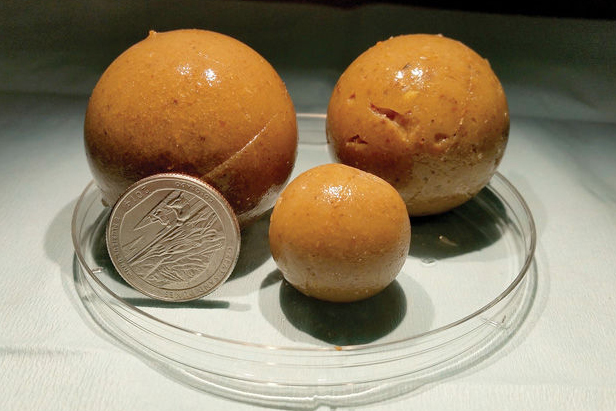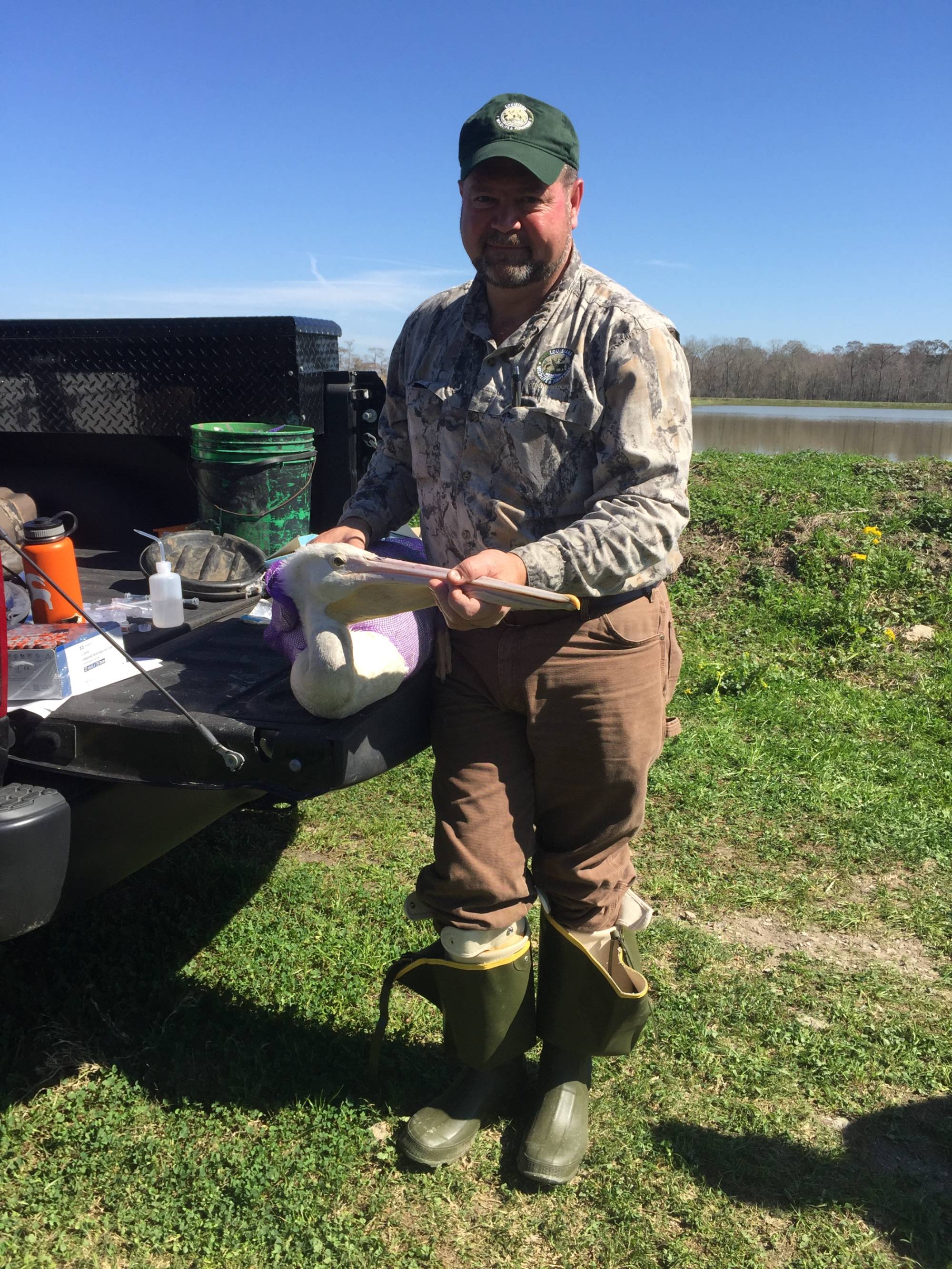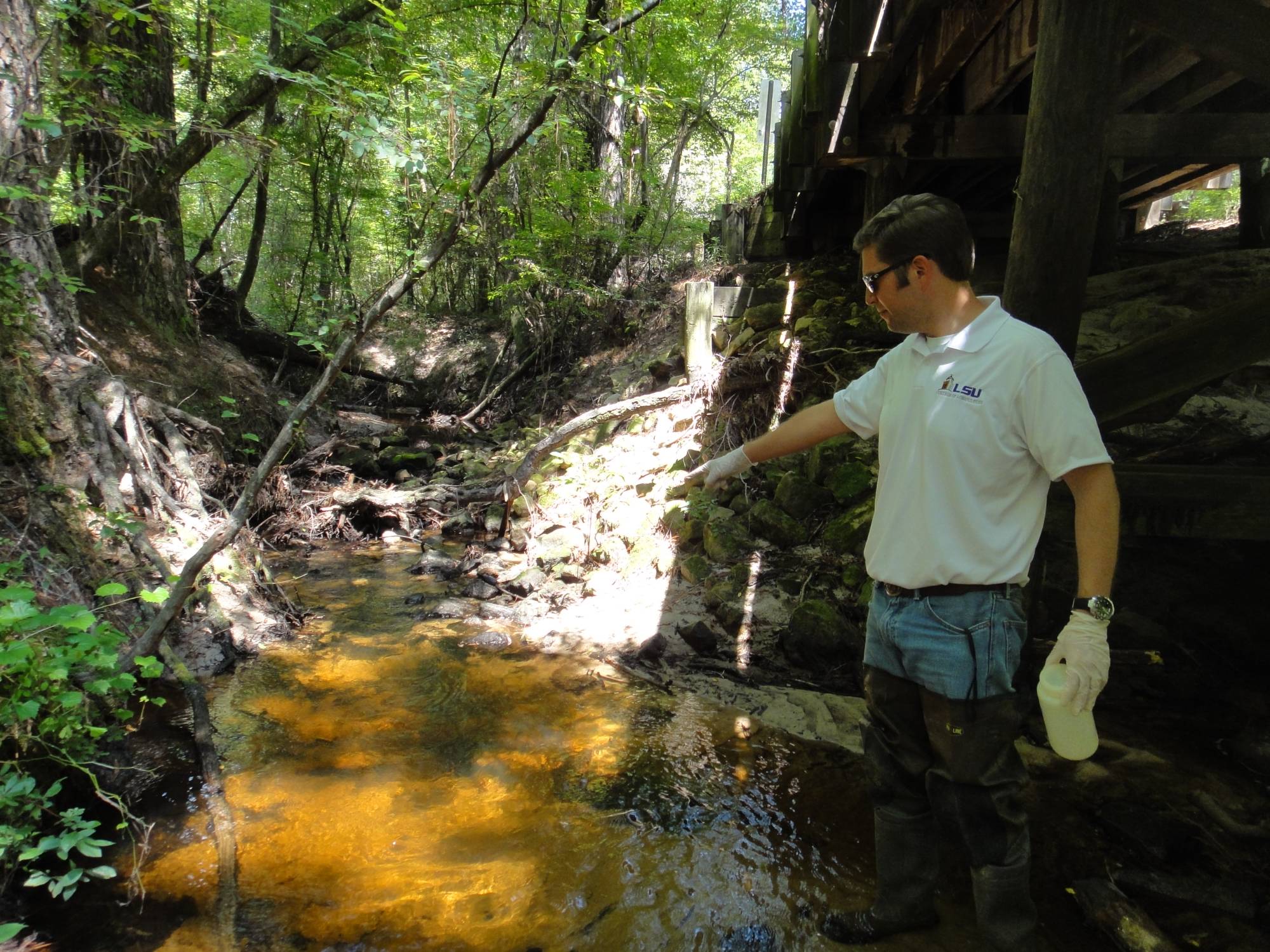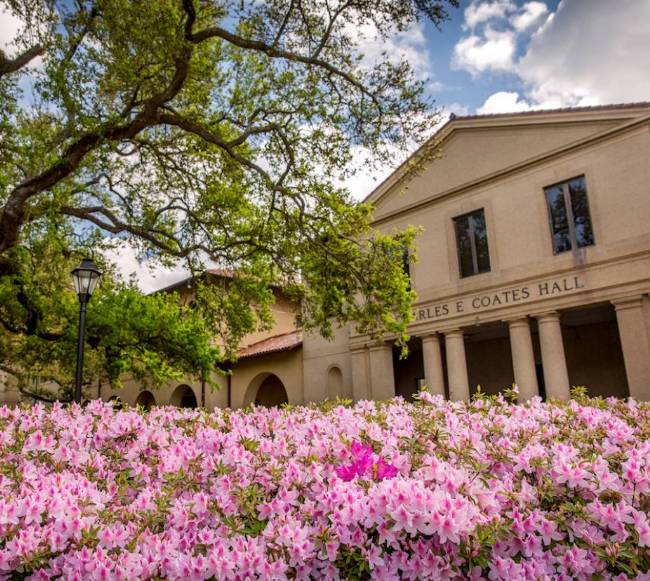LSU Develops Patent-Pending Bait to Fight the ‘Pigdemic’

Wild pigs can replicate quickly. A single sow can produce more than 400 descendants in three years.
Wild, invasive pigs cause more than $90 million in damage to Louisiana farms each year and pose a growing threat to the environment, people and other animals. With $50K in support from the state, LSU is now moving into controlled field trials of a patent-pending bait based on fish, potatoes and, ironically, the key ingredient for bacon.
And while the LSU baits are effective on wild pigs, they have next-to-no impact on the environment, break down quickly and won’t harm animals or humans who might be tempted to eat the pigs.
Wild pigs are everywhere in Louisiana, rampaging through forests and farms, causing significant damage to crops and creating an E. coli problem. There are now more invasive wild pigs in the state than there are people in the most populous cities of New Orleans, Baton Rouge and Shreveport combined—close to 1 million. Pigs reproduce quickly. A single sow can produce more than 400 descendants in three years. When food is abundant, like it is in Louisiana, any local wild pig population can double within mere months.
“In Louisiana, with our growing seasons, there’s always something to eat,” said Glen Gentry, who is an animal scientist and director and coordinator of two LSU AgCenter research stations, including Idlewild, which specializes in wildlife management.

Shelly and Charles Reiners farm rice and soybeans near Crowley. They’ve seen the economic damage from wild pigs triple in the past 15 years.
For close to a decade, Gentry has been working on solutions to the rapidly growing wild pig problem. People hunt and trap pigs, but not nearly enough to keep the population in check. A single sow can produce more than 400 descendants within three years, as her piglets reach maturity in six months and start having piglets of their own. This potential “pigdemic” is why Gentry partnered with LSU chemistry professor John Pojman to develop a solution. Together, they’ve come up with a patent-pending recipe for a bait that wild pigs love to eat (and prefer to corn, acorns and other favorites) but makes them fall asleep. It’s a chewy bait that’s golf-ball-sized. Ironically, the key ingredient is the same as for bacon—pink curing salt, or sodium nitrite.
“As a chemist, I’m quite proud that we’re able to simplify and solve a problem using general chemistry to help the citizens of the state,” Pojman said. “A great advantage of being a land-grant university is that we have both an agriculture college and a chemistry department with complementary expertise to tackle real and pressing problems.”
Luckily, pigs are much more sensitive to nitrites than humans are. Nitrites transform hemoglobin in the blood to methemoglobin, which reduces their body’s ability to get oxygen to cells. Pigs that eat bacon or consume just a few grams of sodium nitrite become starved for oxygen and fall asleep.
Much of Gentry’s research has been supported by statewide commodity groups that represent Louisiana’s rice and soybean farmers.
“The Rice Research Board and the Soybean and Grain Research and Promotion Board have both been very generous in funding my work,” Gentry said. “That’s because they’re directly affected by the damage pigs do.”
Damage to Agriculture
Charles Reiners used a drone to capture video of the damage done by wild pigs to several of his rice plots in Acadia Parish: “It’s very, very frustrating… We want [LSU’s solution] in the field, and quick.”
Acadia Parish farmer Charles Reiners has seen the damage to his rice crop more than triple in the past 15 years. He can now barely access some of his fields because of wild pig activity.
“It would remind you of the Moon out here,” Reiners said. “They’ve dug the roads so full of craters, we can hardly drive down with a pickup truck. They’ve rooted up the whole road.”
“Every farmer out here has this problem with wild pigs and every year it gets worse—meanwhile, everyone’s trying to do something about it,” Reiners continued. “We all trap and shoot, but we need to kill 50 pigs, not just one or two. Some run dogs on them, but then the pigs are moving on your neighbor and that’s not the goal.”
The worst moment, however, comes at harvest time, according to Reiners.
“You’re sitting in the combine in the field and you’re cutting through it and there’s nothing there to harvest,” he said. “The pigs have destroyed as much as 10 percent of our rice fields. It’s very, very frustrating. So, the sooner we get LSU’s solution out here, the better. We want it in the field, and quick.”

The wild pig bait developed by LSU researchers is a bouncy ball loaded with sodium nitrite, which ironically is the key ingredient for bacon. With support from commodity groups and the state, the research is now moving into controlled field trials.
Damage to Aquaculture and Wildlife
Bill Bruce, general manager of the Moore-Odom Wildlife Foundation, which operates wildlife preserves in Calcasieu and Cameron parishes, has also seen significant losses due to wild pigs. Each year, he collects and sells alligator eggs to local alligator farmers. Collection involves helicopters over land and airboats in the marsh, marking alligator nests using GPS and then returning when the time is right to gather eggs. That ‘right time’ is getting to be earlier and earlier in the year, as Bruce tries to get to the eggs before the wild pigs.
“It gets worse by the year,” Bruce said. “Wild pigs eat about 35 percent of our alligator eggs. It’s unreal, like they have a nose for the nests and destroy them in five minutes. It’s a nightmare.”
Rampage vs. R&D
Gentry and Pojman have tested their baits on wild pigs at the Idlewild research station and know they work. With $50K in recent support from the Louisiana legislature and $120K from the Louisiana Department of Wildlife and Fisheries, they’re now moving into semi-controlled field trials using something called “pig brigs,” which are large nets that pigs can push under but get trapped inside as they try to get out.
“To get federal approval and ability to commercialize this, we have to prove the pigs won’t just eat our baits at the research station, but also in the wild,” Gentry said. “The good news about getting them in the nets is that it makes it a lot easier for us to measure effectiveness.”

Jim LaCour, state wildlife veterinarian for the Louisiana Department of Wildlife and Fisheries, appreciates LSU’s “unique and novel approach” to stop the wild pig rampage.
The researchers have already overcome significant hurdles. Gentry countered concerns about pets or other wild animals, including the protected Louisiana black bear, accidentally eating the baits by coming up with a selective delivery system using cameras and cell phones as remote triggers. A deer feeder can be loaded with corn—a favorite food of deer as well as pigs—and baits in separate compartments, so a farmer or other person can wait to release baits until they get visual confirmation that it’s wild pigs, not deer, at the feeder. When the Environmental Protection Agency had questions about potentially poisonous crumbs being left behind—pigs are voracious and messy eaters, after all—Gentry and Pojman staged another experiment. They added a fluorescent dye to the baits and checked for crumbs using a black light. They found no crumbs, partly because LSU’s fish-and-potato-based recipe gives the baits the consistency of gummy bears. Pojman’s team also solved the challenge of sodium nitrite accidentally breaking down into nitrate (with an ‘a,’ it smells like chlorine) by raising the pH using an antacid—“like putting Tums.” In a next step, they’ll tweak the chemistry a bit more so the baits change color when no longer effective, so farmers and others will know when to put in a fresh batch.
“LSU has come up with a unique and novel approach to reduce non-target exposure using the cameras and remote triggers,” said Jim LaCour, state wildlife veterinarian for the Louisiana Department of Wildlife and Fisheries. “The only issue with the setup is that you might have to wake up at 3 a.m. to release baits and don’t always have a cell phone signal.”
To solve this, Gentry is now exploring an alternate delivery method, which we’ll call “the truffle approach.” Pigs can root for baits just as they root for truffles underground. Using either a bulb auger (a large drill that makes circular holes in the ground) or subsoiler pulled behind a tractor (“like pulling a knife through frosting on a cake”), farmers could drop and bury baits along the perimeter of their fields. Pigs, unlike almost every other animal, can smell and root up the baits to eat them, leading the pigs to fall asleep before they get a chance to do much damage. (However, this method can’t be used in areas where there are Louisiana black bears, Gentry is quick to point out. Bears would be able to dig up the baits.)
“It remains to be seen how effective each method will be in the wild,” Gentry said. “You see, pigs are smart and they learn. They’ll walk around a long-grain rice plot to eat medium-grain rice, and we’ve seen them prefer Roundup Ready corn to conventional corn with no genetic modifications. Not that they won’t eat it, but they’ll eat it last. The truth is that with pigs, you just never know quite what to expect.”
A Surprise Finding

Michael Kaller, freshwater ecologist and professor in the LSU School of Renewable Natural Resources, was very surprised at the amount of stress wild pigs add to Louisiana’s aquatic ecosystems. He found significant levels of E. coli and linked the bacteria directly to wild pigs using DNA fingerprinting.
A wild pig surprise to Michael Kaller, a freshwater ecologist and professor in the LSU School of Renewable Natural Resources, was the amount of stress these animals add to Louisiana’s aquatic ecosystems. For many years, Kaller studied streams, bayous and ponds in Allen and Vernon parishes in the western part of the state and Rapides and Natchitoches parishes in central Louisiana. He found significant levels of E. coli at 40% and 55% of the sites, respectively, and linked the bacteria directly to wild pigs using DNA fingerprinting.
“I was surprised, given all of the possible native sources of E. coli, that it was so easy to find the connection,” Kaller said. “Logic suggested it should have been harder due to dilution with the other sources, but the evidence was clear. Wild pigs are impacting these aquatic systems.”
E. coli itself isn’t harmful to aquatic organisms. In humans and pigs, however, as well as in deer, ducks and other native and terrestrial wildlife, E. coli can cause gastrointestinal illness, organ failure and respiratory disease—even death. But while the LSU baits are effective on wild pigs, they have next-to-no impact on the environment, break down quickly and won’t harm animals or humans who might be tempted to eat the pigs.
“You can eat the pigs,” Gentry said. “I have, and they’re delicious!”
Read More
LSU AgCenter Study: Feral Hogs Cost Louisiana Farmers $91 Million Annually (LSU AgCenter, 2022)
Lethal Bait May Lead to Solution of Louisiana’s Feral Pig Problem (LSU AgCenter, 2022)
Feral Pig Baits Showing Promise (LSU AgCenter, 2021)


